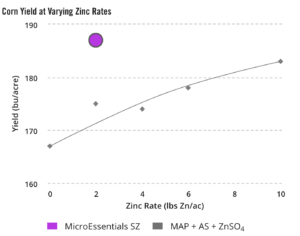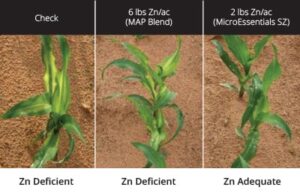OVERVIEW
- MAP + AS + ZnSO₄ is often used as a fertilizer blend applied to corn.
- Nutrient recommendations often call for high rates of Zn due to uneven distribution and lack of crop uptake from a traditional blend.
- MicroEssentials® SZ® contains four nutrients fused into one nutritionally balanced granule, promoting uniform nutrient distribution, improved nutrient uptake and increased yield.
TRIAL DETAILS
Crop: Corn (Zea mays)
Year: 2010-2012
Locations: 11 locations across the U.S. (IN, LA, MN, NE, OH, SC, SD, WI)
Cropping Conditions: Trials conformed to local cropping practices.
N, P and S rates were balanced across treatments (80 lbs P₂O₅/ac, 20 lbs S/ac).
Treatments: MAP + AS + ZnSO₄: 0, 2, 4, 6, and 10 lbs Zn/ac:
MicroEssentials® SZ®: 2 lbs Zn/ac (200 lbs MicroEssentials® SZ®/ac)
Application Timing: Preplant
Application Method: Broadcast
RESULTS


Zinc deficiency symptoms on Check (left) and 6 lbs Zn/ac as a blend (middle) and finally the lack of symptoms for MicroEssentials® SZ® at 2 lbs Zn/ac (right).
SUMMARY
- With a MAP + AS + ZnSO₄ blend, corn yields increased with increasing rates of Zn.
- MicroEssentials® SZ® applied at 2 lbs Zn/ac produced the highest corn yield (186.2 bu/ac), which was statistically higher than 2, 4 and 6 lbs Zn/ac applied as a MAP blend.
- MicroEssentials® SZ® is at least 3X more efficient as a Zn source than a conventional MAP + AS + ZnSO₄ blend.